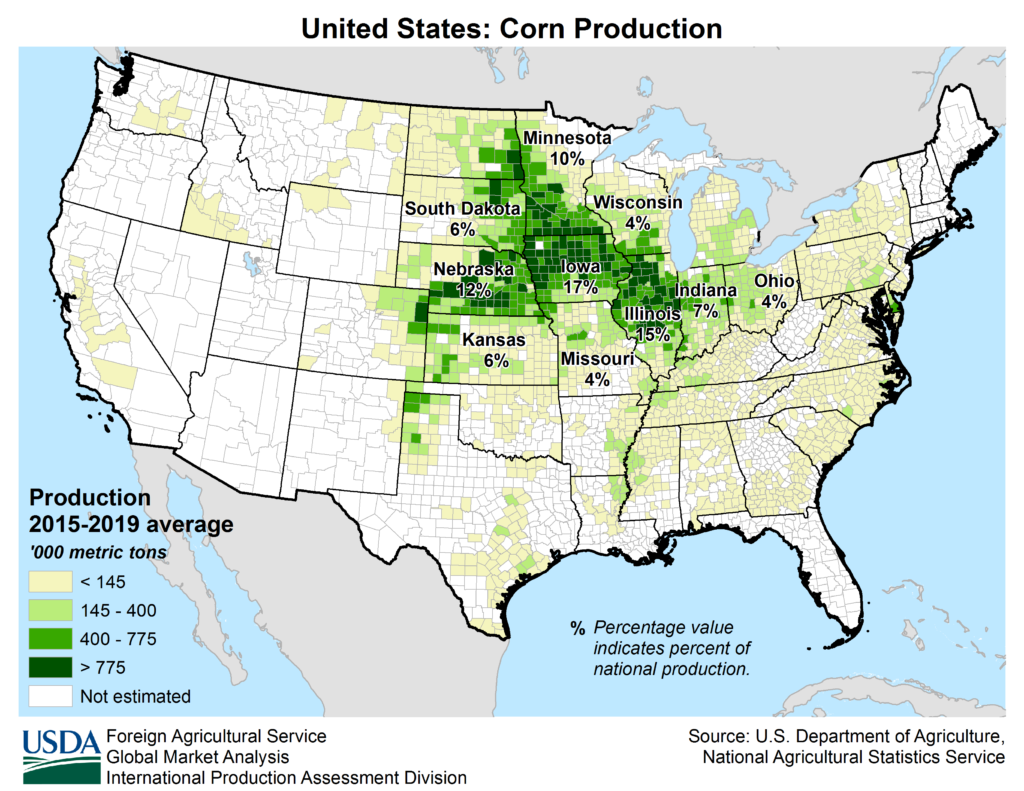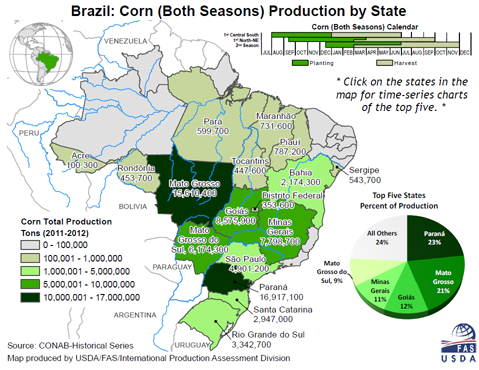Corn
Maize, also known as corn (North American and Australian English), is a cereal grain first domesticated by indigenous peoples in southern Mexico about 10,000 years ago. The leafy stalk of the plant produces pollen inflorescences and separate ovuliferous inflorescences called ears that yield kernels or seeds, which are fruits.
Maize has become a staple food in many parts of the world, with the total production of maize surpassing that of wheat or rice. In addition to being consumed directly by humans (often in the form of masa), maize is also used for corn ethanol, animal feed and other maize products, such as corn starch and corn syrup. The six major types of maize are dent corn, flint corn, pod corn, popcorn, flour corn, and sweet corn. Sugar-rich varieties called sweet corn are usually grown for human consumption as kernels, while field corn varieties are used for animal feed, various corn-based human food uses (including grinding into cornmeal or masa, pressing into corn oil, and fermentation and distillation into alcoholic beverages like bourbon whiskey), and as chemical feedstocks. Maize is also used in making ethanol and other biofuels.
Maize is widely cultivated throughout the world, and a greater weight of maize is produced each year than any other grain. In 2014, total world production was 1.04 billion tonnes. Maize is the most widely grown grain crop throughout the Americas, with 361 million metric tons grown in the United States alone in 2014. Genetically modified maize made up 85% of the maize planted in the United States in 2009. Subsidies in the United States help to account for the high level of cultivation of maize in the United States and the fact that the U.S. is the world’s largest maize producer.


Corn Futures – Contract Specification
| Name | Symbol | Exchange | Size | Months | Tick |
|---|---|---|---|---|---|
| Corn | ZC | CBOT | 5,000 bushels | H,K,N,U,Z | 0.0025 / $12.50 |
Monthly Symbol
| Jan | Feb | Mar | Apr | May | Jun | Jul | Aug | Sep | Oct | Nov | Dec |
| F | G | H | J | K | M | N | Q | U | V | X | Z |
Export Sales
Weekly Historical Data
From USDA: United States Department of Agriculture
The following historical charts covering selected agricultural commodities starting from calendar year 1990 through the current week’s date reflecting weekly exports, accumulated exports, net sales, and outstanding sales for the current marketing year and net sales and outstanding sales for next marketing year are available
Export Sales Weekly Historical Data (USDA)
Corn Futures Price
USDEUR
Long-term interest ratesTotal, % per annum, Jan 2007 – Mar 2021
Social Sentiment
Sentiment Score
Social Sentiment Trend
Coming Soon
Meteo

Report USDA: Prospecting Plantings
This report contains the expected plantings and last year’s harvest for principal crops and tobacco presented on a state basis. Principal crops are as follows: corn, all wheat, winter wheat, durum wheat, other spring wheat, oats, barley, flaxseed, cotton, rice, all sorghum, sweet potatoes, dry edible beans, soybeans, sunflower, peanuts, sugarbeets, canola, and proso millet.
Wasde Report
The World Agricultural Supply and Demand Estimates (WASDE) is prepared and released by the World Agricultural Outlook Board (WAOB). The report is released monthly, and provides annual forecasts for supply and use of U.S. and world wheat, rice, coarse grains, oilseeds, and cotton. The report also covers U.S. supply and use of sugar, meat, poultry eggs and milk, as well as Mexico’s supply and use of sugar. The WAOB chairs the Interagency Commodity Estimates Committees (ICECs), which include analysts from key USDA agencies who compile and interpret information from USDA and other domestic and foreign sources to produce the report. For more information about the WASDE process and data, visit the WASDE FAQs page.
DISCLAIMER:
The above information was drawn from sources believed to be reliable. Although it is believed that information provided is accurate, no guarantee is made. Thinksmart assumes no responsibility for any errors or omissions.
